What's New
Displaying results 4061 - 4070 of 4914
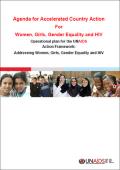
Resource | Publications,
The Agenda for Accelerated Country Action for Women, Girls, Gender Equality and HIV 2010–2014 (Operational Plan) supports the implementation of the UNAIDS Action Framework: Addressing Women, Girls, Gender Equality and HIV. The Action Framework was developed in response to the pressing need to address the persistent gender inequalities and human rights violations that put women and girls at a greater risk of HIV, and increase their vulnerability. These factors also threaten the gains that have been made in preventing HIV transmission and in increasing access to antiretroviral therapy. The UNAIDS Action Framework focuses on action in three areas in which UNAIDS and UNIFEM can make specific and unique contributions.
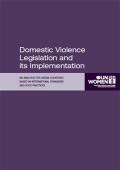
Resource | Publications,
In its General Recommendation 19 the CEDAW Committee states, that the definition of discrimination against women includes gender–based violence, that is "violence that is disproportionately directed against a woman because she is a woman or that affects women disproportionately. It includes acts that inflict physical, mental or sexual harm or suffering, threats of such acts, coercion and other deprivations of liberty. Gender-based violence may breach specific provisions of the Convention, regardless of whether those provisions expressly mention violence".
These research papers - International Standards on Domestic Violence Legislation and Overview of Global Good Practices on Domestic Violence Response Systems prepared by the Lawyers Collective Women's Rights Initiative, India, and contained in this publication, contribute strongly to the enhancement of domestic legislation in the ASEAN region. Drawing on international standards and good practice globally, they not only provide a rich analysis of existing legislation, but a robust framework to enhance the gender responsiveness of legislation and its implementation.

Resource | Publications,
The prevalence of HIV was low in 917 male and transgender sex workers and absent in 533 female sex workers in the study. High levels of current sexually transmitted infections were found, predominantly among transgender sex workers. Risk behaviours were common and knowledge of HIV was extremely low.
The HIV epidemic is currently in its early stages among people who sell sex, but there may be potential for a much greater spread given the levels of other sexually transmitted infections found and the concomitant low levels of both protective knowledge and risk-reducing behaviours. Action is needed now to avert an epidemic. Framing interventions by upholding the recognition and protection of human rights is vital.

Resource | Publications,
HIV epidemic is the single major reversal in human development in modern history. In most heavily affected countries, HIV has drastically reduced life expectancy even by more than 20 years. The estimated number of persons living with HIV in the world in 2007 was 33 million (30 million –36million).
HIV & AIDS, SAARC Region Update 2009 incorporates updated information on HIV/AIDS. This is the seventh annual report on HIV/AIDS situation in the SAARC Region. It includes general information on HIV/AIDS and describes global, regional and SAARC Member States' HIV/AIDS situation in 2007-2008.
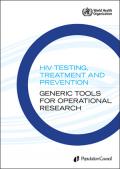
Resource | Publications,
The combined efforts of countries and international partners have resulted in substantial advances in HIV treatment and prevention. Nonetheless, access to key HIV services remains low in many settings around the world, and there are still major research gaps about the best way to expand HIV testing, prevention and treatment, especially in resource-limited settings.
The Generic Tools project is part of WHO's broader efforts to facilitate operational research on HIV testing, treatment and prevention. To identify the information needed to improve HIV programmes, the HIV Department of WHO held international meetings, multi-stakeholder consultations and local workshops, and reviewed the evidence and the availability of data collection tools. These activities highlighted a number of research questions that were amenable to operational research, had relevance in diverse settings, and had the potential to improve programmes and strengthen the evidence base for policies.
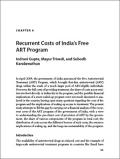
Resource | Publications,
In April 2004, the government of India announced the Free Antiretroviral Treatment (ART) Program, which brought first-line antiretroviral (ARV) drugs within the reach of a much larger pool of ARV-eligible individuals. However, the full costs of providing treatment, the share of costs across entities involved directly or indirectly in the program, and the possible financial implications of a more scaled-up program were not much discussed or analyzed in the country, leaving open many questions regarding the cost of the program and the implications of scaling up access to treatment. The present study attempts to fill this gap by carrying out a financial analysis of the recurrent costs of the ART program of the government of India, with a view to understanding the per-client cost of provision of ART by the government, the share of various components of the program in total cost, the distribution of costs across the different bearers of such costs, the resource implications of scaling up, and the long-run sustainability of the program.
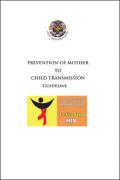
Resource | Guidelines,
Considering the spread of HIV infection among women of the reproductive age, mother–to-child transmission has become a great concern in the area of HIV prevention and health services. The first mother-to-child transmission in Bhutan was reported in the year 2002. Seven cases have now been officially documented. This covers nearly 9% of the total HIV infection in Bhutan. It is inevitable that more pregnant women will be affected in the coming years.
Mother to-child transmission of HIV is the most significant source of HIV infection in children below age of 10 years. Transmission can occur during pregnancy, delivery and after delivery through breast milk. In the absence of appropriate interventions infected child are likely to survive infancy. The extent of HIV infection among pregnant women is often used as an indicator of HIV penetration into the population at large.
The Royal Government has responded by adopting the prevention of mother to child transmission (PMTCT) as an integral part of the nation's response to the HIV/AIDS catastrophe. PMTCT will be a part of a wider response to HIV/AIDS, which includes expanding access to care and support for HIV infected mothers and their families, including treatment of opportunistic infections and accelerating access to treatment. PMTCT prevention should not stand in isolation, but it should be integrated to existing Health care infrastructures and Reproductive Health Services.

Resource | Publications,
This research study on index of stigma and discrimination against HIV-positive people was aimed to promote and support the advocacy of human rights issues in Thailand. It was implemented by the Thai Network of People Living with HIV/AIDS (TNP+) and supported by the Joint United Nations Programme on HIV/AIDS (UNAIDS).
Findings acquired through this project can enable both Thailand and other countries to understand these prevailing social phenomena in conjunction with national rights-related policies, inform program design aiming to resolve and reduce HIV stigma and discrimination issues at implementation level, and advocate for national-level policy.
Data collection took place in mid-2009 through interviews to gather past experiences of positive people in different parts of Thailand. Therefore, the data recorded were incidents that occurred between 2008-2009.

Resource | Publications,
Bangladesh is in the nascent stage of its HIV/AIDS epidemic, as the most recent data indicate an estimated 7,500 persons living with HIV nationwide. In total, 1,207 cases of HIV have been identified since the first case in 1989. Prevalence estimates suggest that HIV/AIDS remains at less than 1% amongst most at -risk populations.
Research conducted by Bangladesh’s International Centre for Diarrhoeal Disease Research, Bangladesh (ICDDR,B) has underscored a number of problematic areas for persons living with HIV (PLHIV), in particular the need to address societal stigma and subsequent discrimination directed at two groups: PLHIV and their health care providers. This study advances prior research with an attempt to document stigma and discrimination both quantitatively using the Stigma Index and qualitatively using focused, in-depth interviews experienced by the PLHIV in Bangladesh.

Resource | Tools,
HIV stigma and discrimination adversely affect every aspect of life for people living with HIV and their families. In many settings, an HIV diagnosis still can be as devastating as the illness itself, leading to job loss, school expulsion, violence, social ostracism, loss of property, and denial of health services and emotional support. People living in fear are less likely to adopt preventive behavior, come in for testing, disclose their sero-status to others, access care and adhere to treatment.
This user guide has been created for teams implementing the People Living with HIV Stigma Index in their communities. This user guide contains background information on the index and its intended purpose; an introduction to the questionnaire and the data gathering process; and practical guidance for training interviewers, ensuring the interview process is conducted in an ethical manner, and for effective data entry and analysis. The guide also includes tips for communicating the research findings and using them to advocate for the rights of people living with HIV.





